Last fall, national Pub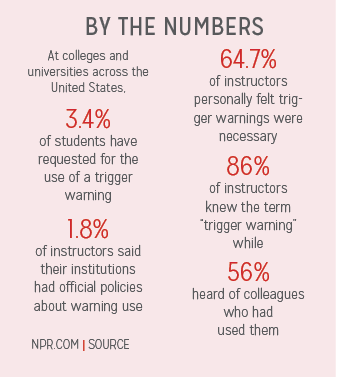 lic Radio (NPR) sent out a survey to colleges and universities across the United States about the usage of “trigger warnings” in class. Just last month, NPR released the survey’s results.
lic Radio (NPR) sent out a survey to colleges and universities across the United States about the usage of “trigger warnings” in class. Just last month, NPR released the survey’s results.
According to the results, trigger warnings, statements used in class to alert students of graphic or controversial material, were found to be used by about half of the professors surveyed. Moreover, the survey indicated that most did it of their own accord.
Nonetheless, at some universities, like the University of Chicago, the use of trigger warnings is frowned upon. At the beginning of this school year, the University of Chicago sent out a formal letter to its incoming freshmen explicitly stating that as a school, it neither condoned nor supported the use of trigger warni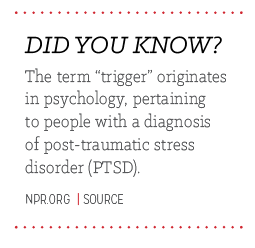 ngs as a commitment to the preservation of the freedom of speech and expression. However, according to NPR, board members at University of Chicago did clarify some professors may still use trigger warnings in class.
ngs as a commitment to the preservation of the freedom of speech and expression. However, according to NPR, board members at University of Chicago did clarify some professors may still use trigger warnings in class.
At CHS, the use of trigger warnings is mixed.
Science teacher Erin Odya said, “In the context of my class, since it’s anatomy and physiology and about the human body and how it works, there are a lot of gory things to show. And so, I always try to, if I’m lecturing or going to watch a video, say, ‘Hey, you’re going to see blood’ or ‘This is a little gross; if you feel a little nauseous, put your head down.’ When you show things like live birth or open-heart surgery, it can be a little overwhel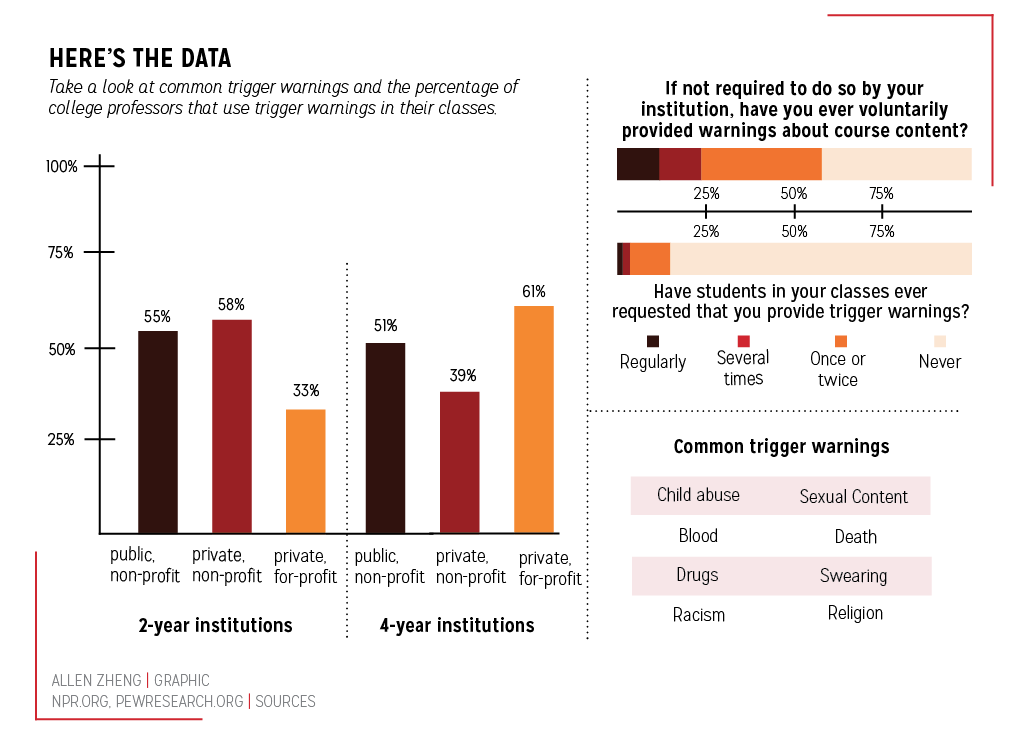 ming for people.”
ming for people.”
According to Odya, since she started teaching anatomy seven years ago, she’s always used some kind of verbal warning. As she is now in tune with the new terminology, she said she would readily classify them as trigger warnings when preparing her class.
However, 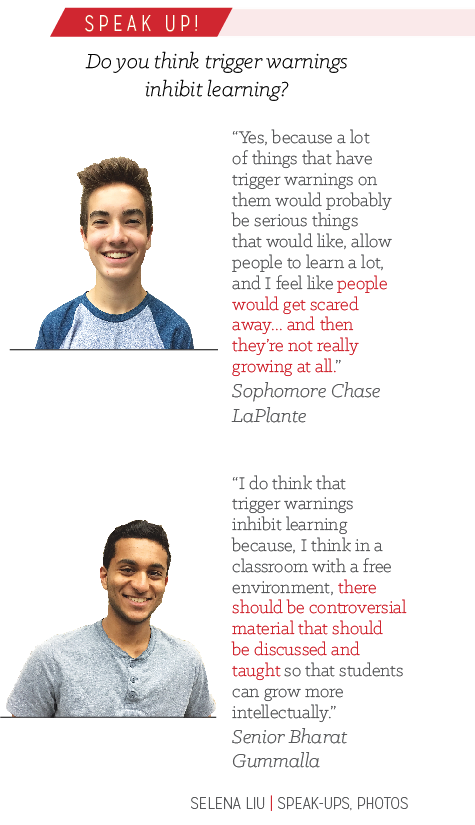 not all teachers define trigger warnings the same way. Science teacher Sarah Gillim said she does indicate to her classes if material may be troublesome, but she hesitates to use the formal term.
not all teachers define trigger warnings the same way. Science teacher Sarah Gillim said she does indicate to her classes if material may be troublesome, but she hesitates to use the formal term.
“I wouldn’t call them trigger warnings,” she said. “If I feel like there’s something that (could be) disturbing to somebody in the class, based on the age group of the class, I’ll say, ‘You might find this a little difficult to watch’ or something of that nature… But, I don’t consciously think that ‘I better give a trigger warning.’”
According to sophomore Sasha Matsuki, students have a right to be warned when something particularly gruesome or controversial is shown or discussed in an educational environment.
Matsuki said, “I think sometimes (trigger warnings) are necessary. If we’re talking about something super gruesome and super awful, then maybe the teacher should say, like when they show movies in class, ‘There’s nudity in this,’ but when they’re talking about something really awful, especially pertaining to history, I think it would just be necessary for some people who are more sensitive to that kind of stuff.”
Still, many teachers said they disagree with the use of trigger warnings and beli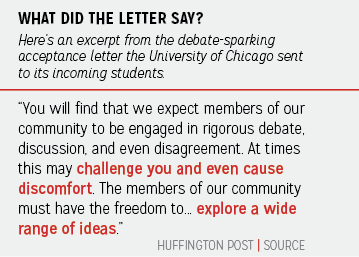 eve all material, no matter how distressing, should be approached with an open mind.
eve all material, no matter how distressing, should be approached with an open mind.
According to English teacher Cristen Cassler, students should approach sensitive material in the classroom with an open mind, especially in regard to literature. Furthermore, she said she believes it is important to stand back and look at others’ perspectives rather than merely at one’s own.
Cassler said, “With the sensitive material that we read in class, I think it’s important to not shy away from it. As a teacher, I think it’s important to explore those issues because literature can bring about some empathy and maybe some new perspective that you didn’t consider before.”

































![AI in films like "The Brutalist" is convenient, but shouldn’t take priority [opinion]](https://hilite.org/wp-content/uploads/2025/02/catherine-cover-1200x471.jpg)









































![Review: “The Immortal Soul Salvage Yard:” A criminally underrated poetry collection [MUSE]](https://hilite.org/wp-content/uploads/2025/03/71cju6TvqmL._AC_UF10001000_QL80_.jpg)
![Review: "Dog Man" is Unapologetically Chaotic [MUSE]](https://hilite.org/wp-content/uploads/2025/03/dogman-1200x700.jpg)
![Review: "Ne Zha 2": The WeChat family reunion I didn’t know I needed [MUSE]](https://hilite.org/wp-content/uploads/2025/03/unnamed-4.png)
![Review in Print: Maripaz Villar brings a delightfully unique style to the world of WEBTOON [MUSE]](https://hilite.org/wp-content/uploads/2023/12/maripazcover-1200x960.jpg)
![Review: “The Sword of Kaigen” is a masterpiece [MUSE]](https://hilite.org/wp-content/uploads/2023/11/Screenshot-2023-11-26-201051.png)
![Review: Gateron Oil Kings, great linear switches, okay price [MUSE]](https://hilite.org/wp-content/uploads/2023/11/Screenshot-2023-11-26-200553.png)
![Review: “A Haunting in Venice” is a significant improvement from other Agatha Christie adaptations [MUSE]](https://hilite.org/wp-content/uploads/2023/11/e7ee2938a6d422669771bce6d8088521.jpg)
![Review: A Thanksgiving story from elementary school, still just as interesting [MUSE]](https://hilite.org/wp-content/uploads/2023/11/Screenshot-2023-11-26-195514-987x1200.png)
![Review: "When I Fly Towards You", cute, uplifting youth drama [MUSE]](https://hilite.org/wp-content/uploads/2023/09/When-I-Fly-Towards-You-Chinese-drama.png)
![Postcards from Muse: Hawaii Travel Diary [MUSE]](https://hilite.org/wp-content/uploads/2023/09/My-project-1-1200x1200.jpg)
![Review: "Ladybug & Cat Noir: The Movie," departure from original show [MUSE]](https://hilite.org/wp-content/uploads/2023/09/Ladybug__Cat_Noir_-_The_Movie_poster.jpg)
![Review in Print: "Hidden Love" is the cute, uplifting drama everyone needs [MUSE]](https://hilite.org/wp-content/uploads/2023/09/hiddenlovecover-e1693597208225-1030x1200.png)
![Review in Print: "Heartstopper" is the heartwarming queer romance we all need [MUSE]](https://hilite.org/wp-content/uploads/2023/08/museheartstoppercover-1200x654.png)



